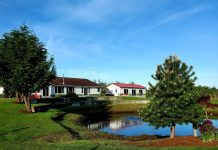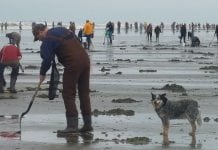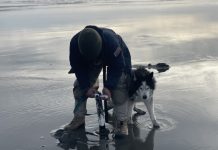This calendar is the place to find fun events happening throughout Grays Harbor County including Aberdeen, Hoquiam, Westport, Ocean Shores, Elma, Montesano and beyond.
Have an event that isn’t listed? Please email events@GraysHarborTalk.com with the following information:
- Name of Event
- Date, time and location (name of business if applicable and complete address)
- Organizer(s) name
- Cost
- URL to purchase tickets
- Website URL
- SHORT description of event
- Photo
Our editors will review and post within a few business days.
Come celebrate summer at the beach with one of the largest events in Ocean Shores – Five Star Dealerships’ Sand and Sawdust Festival on Friday, June 28th through Sunday, June 30th. This free annual festival located at the Ocean Shores Convention Center celebrates our State’s timberlands and our beaches with a Chainsaw Art Show and Auction and Sandcastle and Sand Sculpture Contest.
Come celebrate summer at the beach with one of the largest events in Ocean Shores – Five Star Dealerships’ Sand and Sawdust Festival on Friday, June 28th through Sunday, June 30th. This free annual festival located at the Ocean Shores Convention Center celebrates our State’s timberlands and our beaches with a Chainsaw Art Show and Auction and Sandcastle and Sand Sculpture Contest.
Come celebrate summer at the beach with one of the largest events in Ocean Shores – Five Star Dealerships’ Sand and Sawdust Festival on Friday, June 28th through Sunday, June 30th. This free annual festival located at the Ocean Shores Convention Center celebrates our State’s timberlands and our beaches with a Chainsaw Art Show and Auction and Sandcastle and Sand Sculpture Contest.
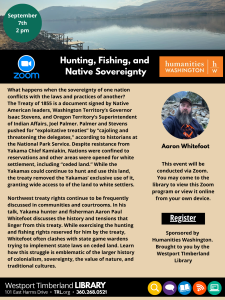
Humanities Washington Speaker Event:
Hunting, Fishing, and Native Sovereignty-Aaron Whitefoot
What happens when the sovereignty of one nation conflicts with the laws and practices of another?
The Treaty of 1855 is a document signed by Native American leaders, Washington Territory’s Governor Isaac Stevens, and Oregon Territory’s Superintendent of Indian Affairs, Joel Palmer. Palmer and Stevens pushed for “exploitative treaties” by “cajoling and threatening the delegates,” according to historians at the National Park Service. Despite resistance from Yakama Chief Kamiakin, Nations were confined to reservations and other areas were opened for white settlement, including “ceded land.” While the Yakamas could continue to hunt and use this land, the treaty removed the Yakamas’ exclusive use of it, granting wide access to of the land to white settlers.
Northwest treaty rights continue to be frequently discussed in communities and courtrooms. In his talk, Yakama hunter and fisherman Aaron Paul Whitefoot discusses the history and tensions that linger from this treaty. While exercising the hunting and fishing rights reserved for him by the treaty, Whitefoot often clashes with state game wardens trying to implement state laws on ceded land. Learn how this struggle is emblematic of the larger history of colonialism, sovereignty, the value of nature, and traditional cultures.
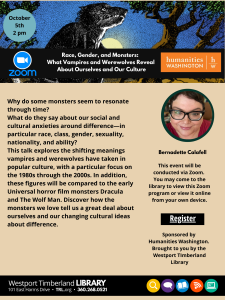
Humanities Washington Speaker Event:
Race, Gender, and Monsters: What Vampires and Werewolves Reveal About Ourselves and Our Culture- Bernadette Calafell
Why do some monsters seem to resonate through time?
What do they say about our social and cultural anxieties around difference—in particular race, class, gender, sexuality, nationality, and ability?
This talk explores the shifting meanings vampires and werewolves have taken in popular culture, with a particular focus on the 1980s through the 2000s. In addition, these figures will be compared to the early Universal horror film monsters Dracula and The Wolf Man. Discover how the monsters we love tell us a great deal about ourselves and our changing cultural ideas about difference.
“It was a great first tide series of the season last week (Oct. 3-7) with soft wind, calm waves, and dry skies that resulted in mostly limits for those that came out,” said Bryce Blumenthal, a WDFW coastal shellfish biologist. “We are hoping this next tide series will bring similar success with lower and earlier tides that should allow for daylight digging opportunity the first few days.”
In early fall the beaches still have a lot of sand built up, which can make beach driving hazardous. WDFW asks diggers to drive carefully on the uppermost part of the hard-packed sand, avoid wet sand and not to create congestion leading on and off the beach by parking on the approaches.
The Washington Department of Health (DOH) requires test samples for marine toxins, and domoic acid levels must fall under the guideline level before a beach can open for digging. Domoic acid, a natural toxin produced by certain types of marine algae, can be harmful or fatal if consumed in sufficient quantities. Final approval usually occurs about a week or less – sometimes two to three days – before the start of each digging series. More information about domoic acid, as well as current levels at ocean beaches, can be found on the WDFW’s domoic acid webpage.
The following digs during evening (p.m.) low tides will proceed as scheduled, after marine toxin results from the DOH showed razor clams are safe to eat:
- Oct. 15, Tuesday, 5:31 p.m.; 0.5 feet; Long Beach, Twin Harbors, Mocrocks
- Oct. 16, Wednesday, 6:18 p.m.; -0.5 feet; Long Beach, Twin Harbors, Copalis
- Oct. 17, Thursday, 7:03 p.m.; -1.3 feet; Long Beach, Twin Harbors, Copalis
- Oct. 18, Friday, 7:49 p.m.; -1.7 feet; Long Beach, Twin Harbors, Mocrocks
- Oct. 19, Saturday, 8:35 p.m.; -1.7 feet; Long Beach, Twin Harbors, Mocrocks
- Oct. 20, Sunday, 9:24 p.m.; -1.4 feet; Long Beach, Twin Harbors, Copalis
- Oct. 21, Monday, 10:16 p.m.; -0.8 feet; Long Beach, Twin Harbors, Copalis















